SBM4203 - Management Information Systems: Analysis of Managerial Role
VerifiedAdded on 2023/06/09
|9
|1936
|298
Report
AI Summary
This report provides a comprehensive overview of the managerial role within the context of Management Information Systems (MIS). It outlines the primary objectives and responsibilities of a manager, including ensuring workforce safety, achieving organizational goals, and enhancing employee development. The report details essential job requirements, physical demands, and the work environment of a manager. It also explores key personality characteristics of successful managers, such as being team-oriented, possessing good communication skills, and demonstrating transparency. Furthermore, the report examines the various individuals a manager interacts with, including top management, teams, internal and external customers, government entities, and contractors, highlighting the importance of effective stakeholder management for organizational effectiveness. The report concludes by emphasizing strategies to enhance managerial effectiveness, such as building strong teams and fostering motivation and productivity among employees.
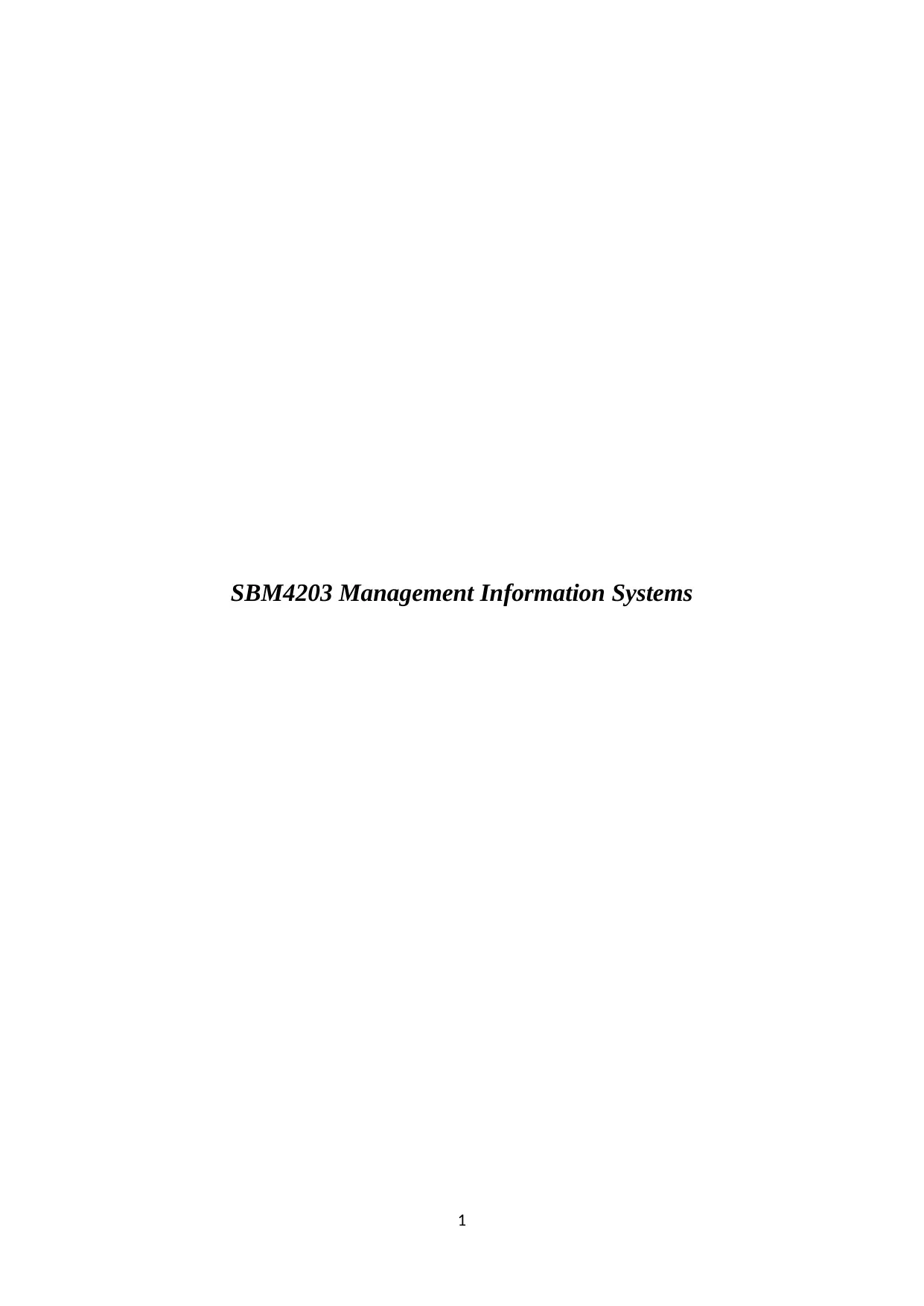
SBM4203 Management Information Systems
1
1
Paraphrase This Document
Need a fresh take? Get an instant paraphrase of this document with our AI Paraphraser
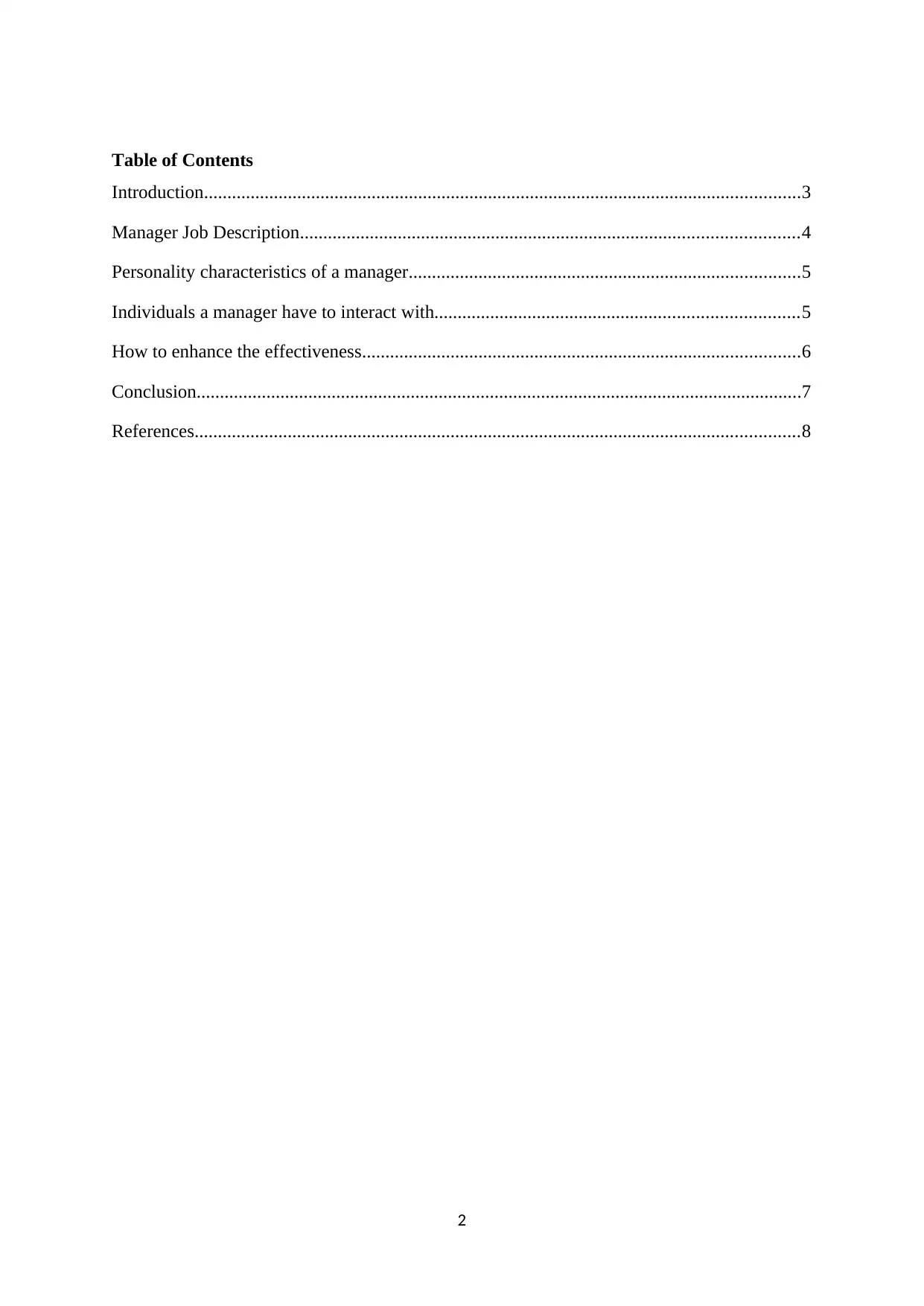
Table of Contents
Introduction................................................................................................................................3
Manager Job Description...........................................................................................................4
Personality characteristics of a manager....................................................................................5
Individuals a manager have to interact with..............................................................................5
How to enhance the effectiveness..............................................................................................6
Conclusion..................................................................................................................................7
References..................................................................................................................................8
2
Introduction................................................................................................................................3
Manager Job Description...........................................................................................................4
Personality characteristics of a manager....................................................................................5
Individuals a manager have to interact with..............................................................................5
How to enhance the effectiveness..............................................................................................6
Conclusion..................................................................................................................................7
References..................................................................................................................................8
2
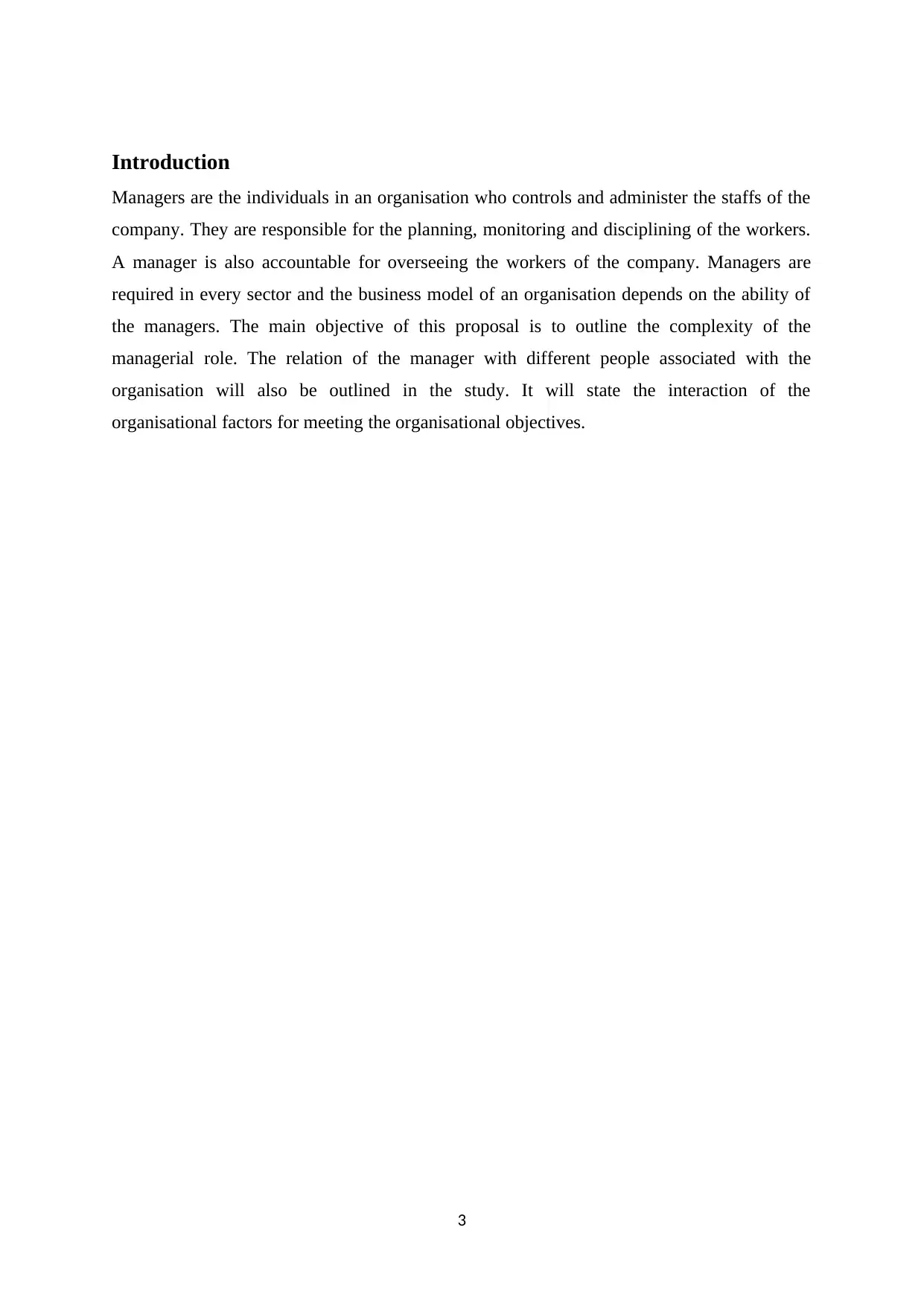
Introduction
Managers are the individuals in an organisation who controls and administer the staffs of the
company. They are responsible for the planning, monitoring and disciplining of the workers.
A manager is also accountable for overseeing the workers of the company. Managers are
required in every sector and the business model of an organisation depends on the ability of
the managers. The main objective of this proposal is to outline the complexity of the
managerial role. The relation of the manager with different people associated with the
organisation will also be outlined in the study. It will state the interaction of the
organisational factors for meeting the organisational objectives.
3
Managers are the individuals in an organisation who controls and administer the staffs of the
company. They are responsible for the planning, monitoring and disciplining of the workers.
A manager is also accountable for overseeing the workers of the company. Managers are
required in every sector and the business model of an organisation depends on the ability of
the managers. The main objective of this proposal is to outline the complexity of the
managerial role. The relation of the manager with different people associated with the
organisation will also be outlined in the study. It will state the interaction of the
organisational factors for meeting the organisational objectives.
3
⊘ This is a preview!⊘
Do you want full access?
Subscribe today to unlock all pages.

Trusted by 1+ million students worldwide
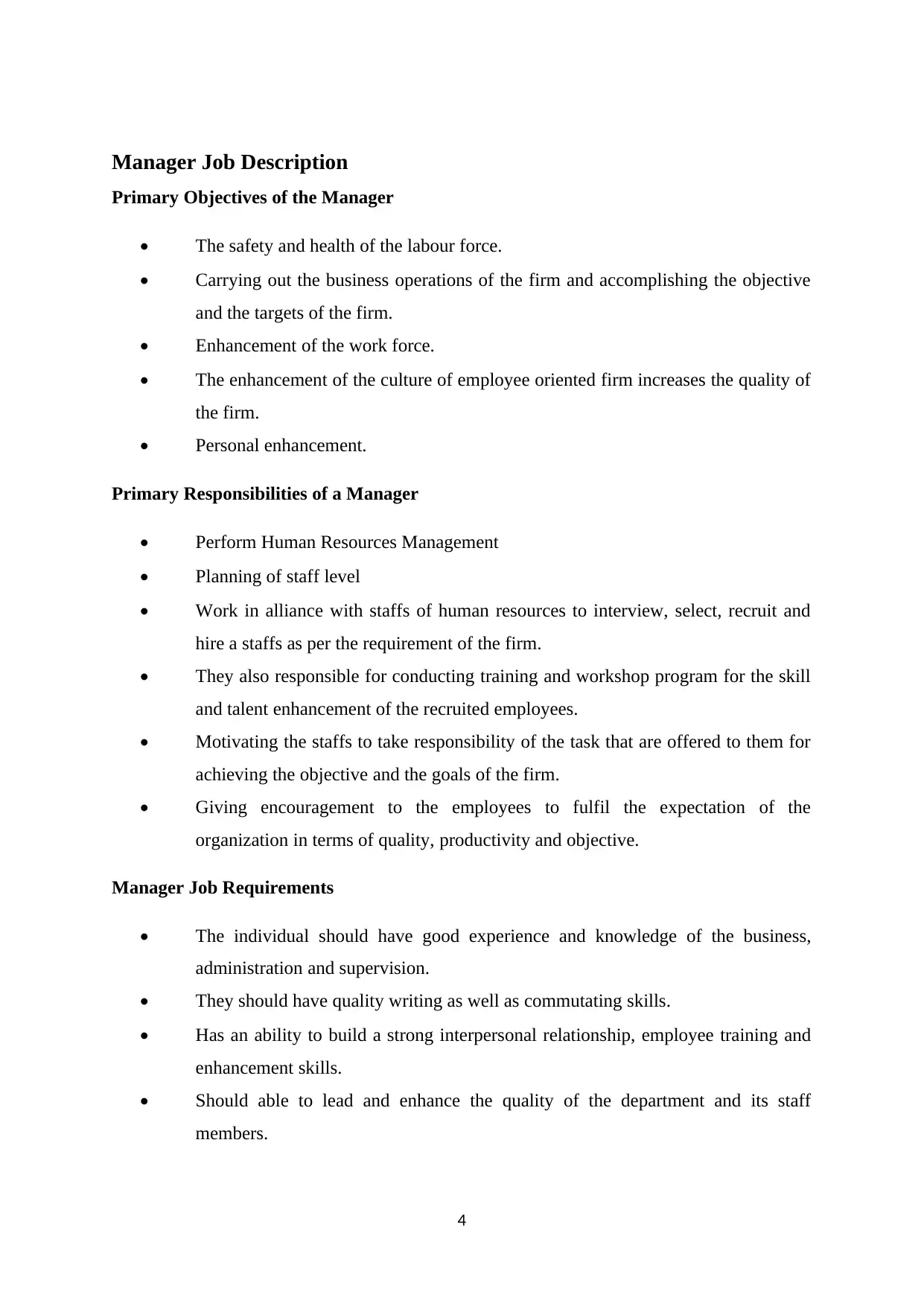
Manager Job Description
Primary Objectives of the Manager
• The safety and health of the labour force.
• Carrying out the business operations of the firm and accomplishing the objective
and the targets of the firm.
• Enhancement of the work force.
• The enhancement of the culture of employee oriented firm increases the quality of
the firm.
• Personal enhancement.
Primary Responsibilities of a Manager
• Perform Human Resources Management
• Planning of staff level
• Work in alliance with staffs of human resources to interview, select, recruit and
hire a staffs as per the requirement of the firm.
• They also responsible for conducting training and workshop program for the skill
and talent enhancement of the recruited employees.
• Motivating the staffs to take responsibility of the task that are offered to them for
achieving the objective and the goals of the firm.
• Giving encouragement to the employees to fulfil the expectation of the
organization in terms of quality, productivity and objective.
Manager Job Requirements
• The individual should have good experience and knowledge of the business,
administration and supervision.
• They should have quality writing as well as commutating skills.
• Has an ability to build a strong interpersonal relationship, employee training and
enhancement skills.
• Should able to lead and enhance the quality of the department and its staff
members.
4
Primary Objectives of the Manager
• The safety and health of the labour force.
• Carrying out the business operations of the firm and accomplishing the objective
and the targets of the firm.
• Enhancement of the work force.
• The enhancement of the culture of employee oriented firm increases the quality of
the firm.
• Personal enhancement.
Primary Responsibilities of a Manager
• Perform Human Resources Management
• Planning of staff level
• Work in alliance with staffs of human resources to interview, select, recruit and
hire a staffs as per the requirement of the firm.
• They also responsible for conducting training and workshop program for the skill
and talent enhancement of the recruited employees.
• Motivating the staffs to take responsibility of the task that are offered to them for
achieving the objective and the goals of the firm.
• Giving encouragement to the employees to fulfil the expectation of the
organization in terms of quality, productivity and objective.
Manager Job Requirements
• The individual should have good experience and knowledge of the business,
administration and supervision.
• They should have quality writing as well as commutating skills.
• Has an ability to build a strong interpersonal relationship, employee training and
enhancement skills.
• Should able to lead and enhance the quality of the department and its staff
members.
4
Paraphrase This Document
Need a fresh take? Get an instant paraphrase of this document with our AI Paraphraser
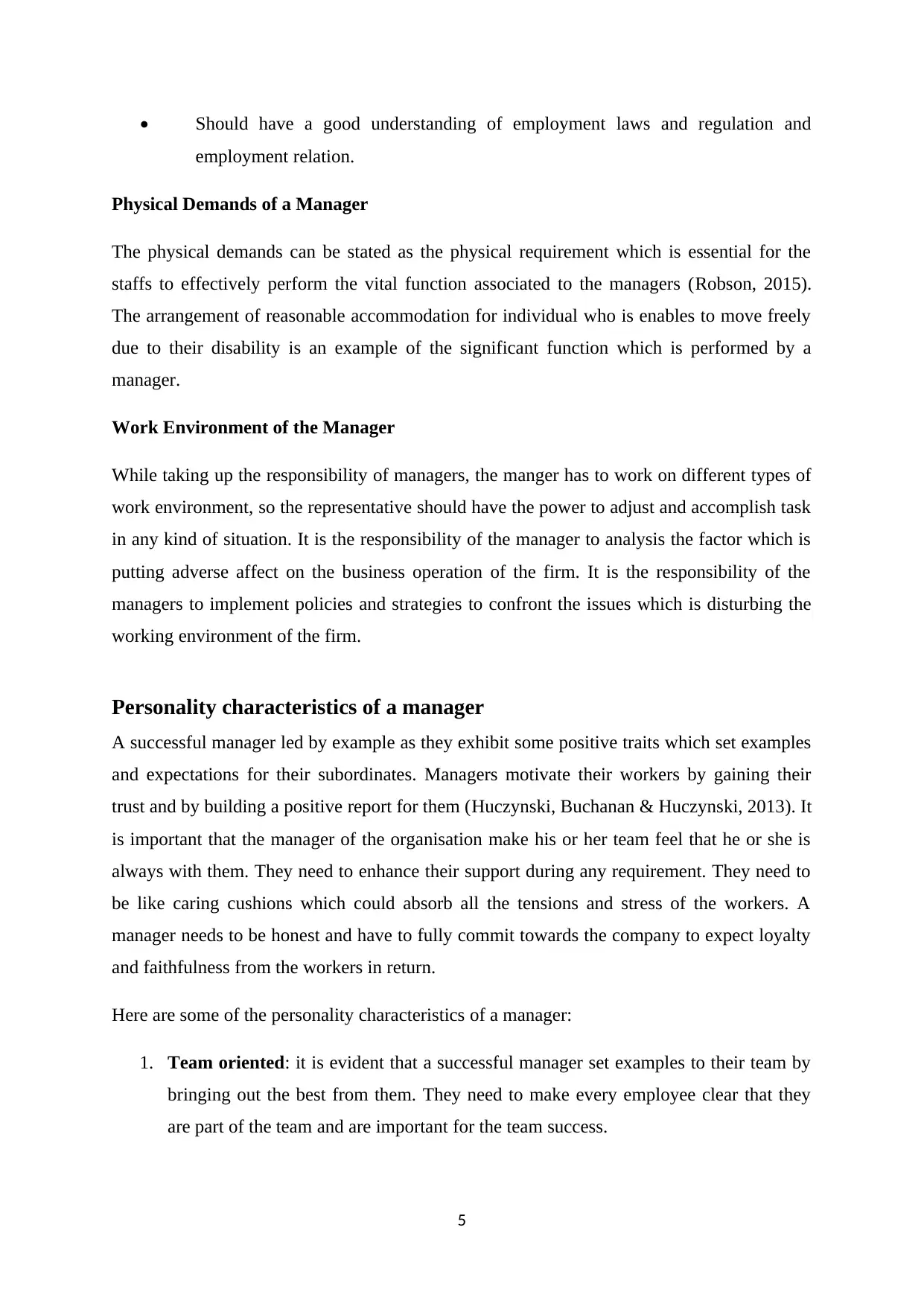
• Should have a good understanding of employment laws and regulation and
employment relation.
Physical Demands of a Manager
The physical demands can be stated as the physical requirement which is essential for the
staffs to effectively perform the vital function associated to the managers (Robson, 2015).
The arrangement of reasonable accommodation for individual who is enables to move freely
due to their disability is an example of the significant function which is performed by a
manager.
Work Environment of the Manager
While taking up the responsibility of managers, the manger has to work on different types of
work environment, so the representative should have the power to adjust and accomplish task
in any kind of situation. It is the responsibility of the manager to analysis the factor which is
putting adverse affect on the business operation of the firm. It is the responsibility of the
managers to implement policies and strategies to confront the issues which is disturbing the
working environment of the firm.
Personality characteristics of a manager
A successful manager led by example as they exhibit some positive traits which set examples
and expectations for their subordinates. Managers motivate their workers by gaining their
trust and by building a positive report for them (Huczynski, Buchanan & Huczynski, 2013). It
is important that the manager of the organisation make his or her team feel that he or she is
always with them. They need to enhance their support during any requirement. They need to
be like caring cushions which could absorb all the tensions and stress of the workers. A
manager needs to be honest and have to fully commit towards the company to expect loyalty
and faithfulness from the workers in return.
Here are some of the personality characteristics of a manager:
1. Team oriented: it is evident that a successful manager set examples to their team by
bringing out the best from them. They need to make every employee clear that they
are part of the team and are important for the team success.
5
employment relation.
Physical Demands of a Manager
The physical demands can be stated as the physical requirement which is essential for the
staffs to effectively perform the vital function associated to the managers (Robson, 2015).
The arrangement of reasonable accommodation for individual who is enables to move freely
due to their disability is an example of the significant function which is performed by a
manager.
Work Environment of the Manager
While taking up the responsibility of managers, the manger has to work on different types of
work environment, so the representative should have the power to adjust and accomplish task
in any kind of situation. It is the responsibility of the manager to analysis the factor which is
putting adverse affect on the business operation of the firm. It is the responsibility of the
managers to implement policies and strategies to confront the issues which is disturbing the
working environment of the firm.
Personality characteristics of a manager
A successful manager led by example as they exhibit some positive traits which set examples
and expectations for their subordinates. Managers motivate their workers by gaining their
trust and by building a positive report for them (Huczynski, Buchanan & Huczynski, 2013). It
is important that the manager of the organisation make his or her team feel that he or she is
always with them. They need to enhance their support during any requirement. They need to
be like caring cushions which could absorb all the tensions and stress of the workers. A
manager needs to be honest and have to fully commit towards the company to expect loyalty
and faithfulness from the workers in return.
Here are some of the personality characteristics of a manager:
1. Team oriented: it is evident that a successful manager set examples to their team by
bringing out the best from them. They need to make every employee clear that they
are part of the team and are important for the team success.
5
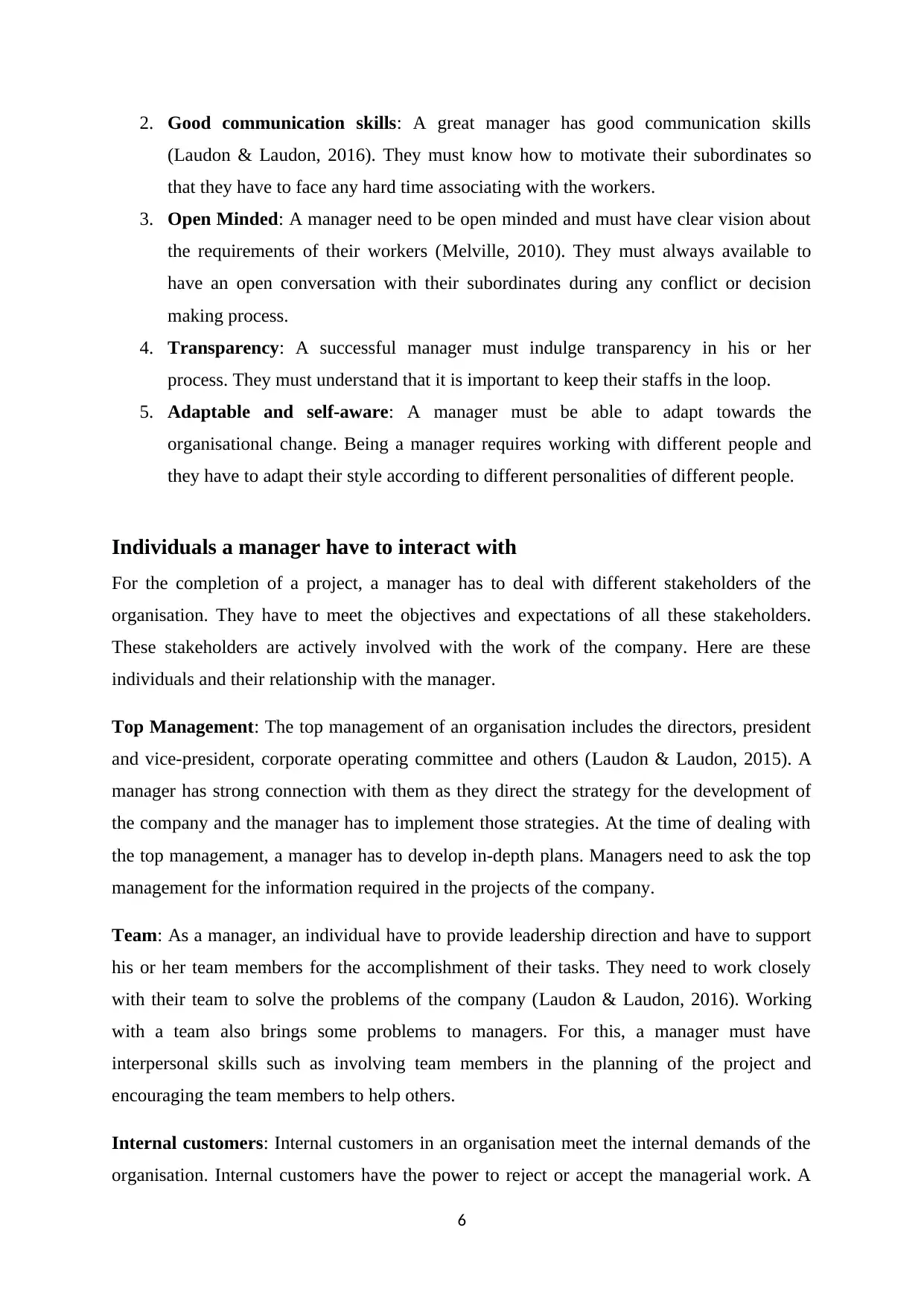
2. Good communication skills: A great manager has good communication skills
(Laudon & Laudon, 2016). They must know how to motivate their subordinates so
that they have to face any hard time associating with the workers.
3. Open Minded: A manager need to be open minded and must have clear vision about
the requirements of their workers (Melville, 2010). They must always available to
have an open conversation with their subordinates during any conflict or decision
making process.
4. Transparency: A successful manager must indulge transparency in his or her
process. They must understand that it is important to keep their staffs in the loop.
5. Adaptable and self-aware: A manager must be able to adapt towards the
organisational change. Being a manager requires working with different people and
they have to adapt their style according to different personalities of different people.
Individuals a manager have to interact with
For the completion of a project, a manager has to deal with different stakeholders of the
organisation. They have to meet the objectives and expectations of all these stakeholders.
These stakeholders are actively involved with the work of the company. Here are these
individuals and their relationship with the manager.
Top Management: The top management of an organisation includes the directors, president
and vice-president, corporate operating committee and others (Laudon & Laudon, 2015). A
manager has strong connection with them as they direct the strategy for the development of
the company and the manager has to implement those strategies. At the time of dealing with
the top management, a manager has to develop in-depth plans. Managers need to ask the top
management for the information required in the projects of the company.
Team: As a manager, an individual have to provide leadership direction and have to support
his or her team members for the accomplishment of their tasks. They need to work closely
with their team to solve the problems of the company (Laudon & Laudon, 2016). Working
with a team also brings some problems to managers. For this, a manager must have
interpersonal skills such as involving team members in the planning of the project and
encouraging the team members to help others.
Internal customers: Internal customers in an organisation meet the internal demands of the
organisation. Internal customers have the power to reject or accept the managerial work. A
6
(Laudon & Laudon, 2016). They must know how to motivate their subordinates so
that they have to face any hard time associating with the workers.
3. Open Minded: A manager need to be open minded and must have clear vision about
the requirements of their workers (Melville, 2010). They must always available to
have an open conversation with their subordinates during any conflict or decision
making process.
4. Transparency: A successful manager must indulge transparency in his or her
process. They must understand that it is important to keep their staffs in the loop.
5. Adaptable and self-aware: A manager must be able to adapt towards the
organisational change. Being a manager requires working with different people and
they have to adapt their style according to different personalities of different people.
Individuals a manager have to interact with
For the completion of a project, a manager has to deal with different stakeholders of the
organisation. They have to meet the objectives and expectations of all these stakeholders.
These stakeholders are actively involved with the work of the company. Here are these
individuals and their relationship with the manager.
Top Management: The top management of an organisation includes the directors, president
and vice-president, corporate operating committee and others (Laudon & Laudon, 2015). A
manager has strong connection with them as they direct the strategy for the development of
the company and the manager has to implement those strategies. At the time of dealing with
the top management, a manager has to develop in-depth plans. Managers need to ask the top
management for the information required in the projects of the company.
Team: As a manager, an individual have to provide leadership direction and have to support
his or her team members for the accomplishment of their tasks. They need to work closely
with their team to solve the problems of the company (Laudon & Laudon, 2016). Working
with a team also brings some problems to managers. For this, a manager must have
interpersonal skills such as involving team members in the planning of the project and
encouraging the team members to help others.
Internal customers: Internal customers in an organisation meet the internal demands of the
organisation. Internal customers have the power to reject or accept the managerial work. A
6
⊘ This is a preview!⊘
Do you want full access?
Subscribe today to unlock all pages.

Trusted by 1+ million students worldwide
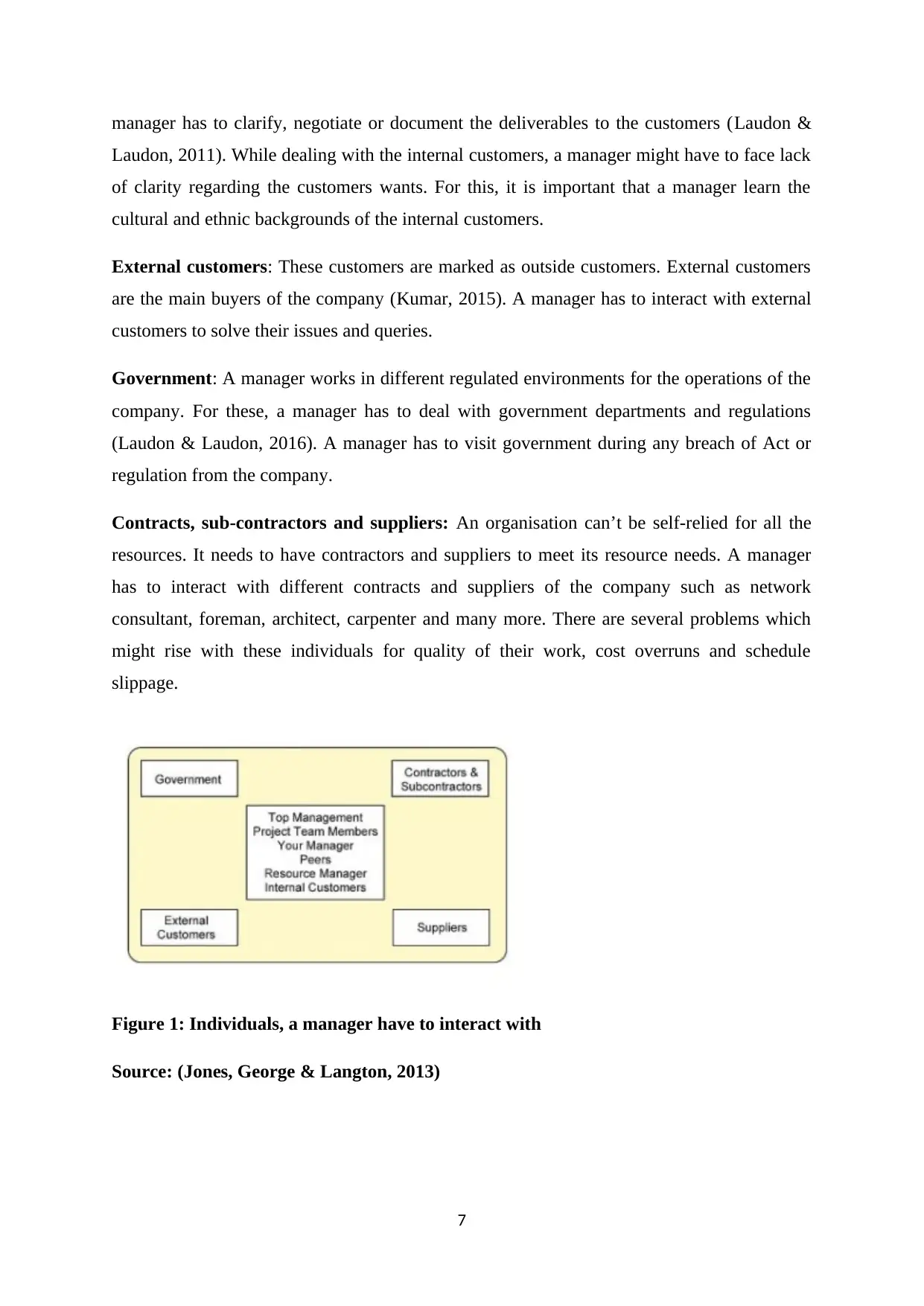
manager has to clarify, negotiate or document the deliverables to the customers (Laudon &
Laudon, 2011). While dealing with the internal customers, a manager might have to face lack
of clarity regarding the customers wants. For this, it is important that a manager learn the
cultural and ethnic backgrounds of the internal customers.
External customers: These customers are marked as outside customers. External customers
are the main buyers of the company (Kumar, 2015). A manager has to interact with external
customers to solve their issues and queries.
Government: A manager works in different regulated environments for the operations of the
company. For these, a manager has to deal with government departments and regulations
(Laudon & Laudon, 2016). A manager has to visit government during any breach of Act or
regulation from the company.
Contracts, sub-contractors and suppliers: An organisation can’t be self-relied for all the
resources. It needs to have contractors and suppliers to meet its resource needs. A manager
has to interact with different contracts and suppliers of the company such as network
consultant, foreman, architect, carpenter and many more. There are several problems which
might rise with these individuals for quality of their work, cost overruns and schedule
slippage.
Figure 1: Individuals, a manager have to interact with
Source: (Jones, George & Langton, 2013)
7
Laudon, 2011). While dealing with the internal customers, a manager might have to face lack
of clarity regarding the customers wants. For this, it is important that a manager learn the
cultural and ethnic backgrounds of the internal customers.
External customers: These customers are marked as outside customers. External customers
are the main buyers of the company (Kumar, 2015). A manager has to interact with external
customers to solve their issues and queries.
Government: A manager works in different regulated environments for the operations of the
company. For these, a manager has to deal with government departments and regulations
(Laudon & Laudon, 2016). A manager has to visit government during any breach of Act or
regulation from the company.
Contracts, sub-contractors and suppliers: An organisation can’t be self-relied for all the
resources. It needs to have contractors and suppliers to meet its resource needs. A manager
has to interact with different contracts and suppliers of the company such as network
consultant, foreman, architect, carpenter and many more. There are several problems which
might rise with these individuals for quality of their work, cost overruns and schedule
slippage.
Figure 1: Individuals, a manager have to interact with
Source: (Jones, George & Langton, 2013)
7
Paraphrase This Document
Need a fresh take? Get an instant paraphrase of this document with our AI Paraphraser
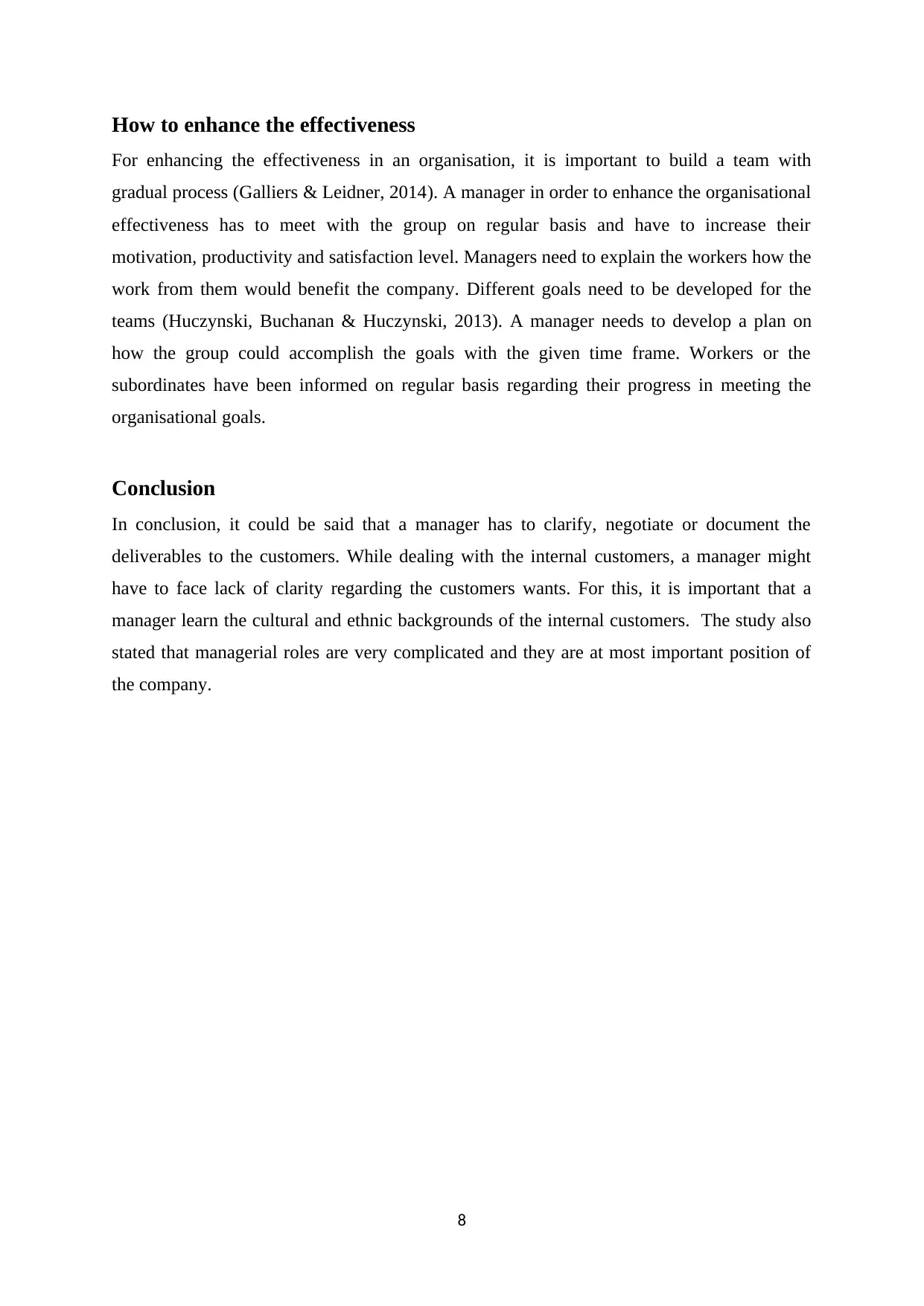
How to enhance the effectiveness
For enhancing the effectiveness in an organisation, it is important to build a team with
gradual process (Galliers & Leidner, 2014). A manager in order to enhance the organisational
effectiveness has to meet with the group on regular basis and have to increase their
motivation, productivity and satisfaction level. Managers need to explain the workers how the
work from them would benefit the company. Different goals need to be developed for the
teams (Huczynski, Buchanan & Huczynski, 2013). A manager needs to develop a plan on
how the group could accomplish the goals with the given time frame. Workers or the
subordinates have been informed on regular basis regarding their progress in meeting the
organisational goals.
Conclusion
In conclusion, it could be said that a manager has to clarify, negotiate or document the
deliverables to the customers. While dealing with the internal customers, a manager might
have to face lack of clarity regarding the customers wants. For this, it is important that a
manager learn the cultural and ethnic backgrounds of the internal customers. The study also
stated that managerial roles are very complicated and they are at most important position of
the company.
8
For enhancing the effectiveness in an organisation, it is important to build a team with
gradual process (Galliers & Leidner, 2014). A manager in order to enhance the organisational
effectiveness has to meet with the group on regular basis and have to increase their
motivation, productivity and satisfaction level. Managers need to explain the workers how the
work from them would benefit the company. Different goals need to be developed for the
teams (Huczynski, Buchanan & Huczynski, 2013). A manager needs to develop a plan on
how the group could accomplish the goals with the given time frame. Workers or the
subordinates have been informed on regular basis regarding their progress in meeting the
organisational goals.
Conclusion
In conclusion, it could be said that a manager has to clarify, negotiate or document the
deliverables to the customers. While dealing with the internal customers, a manager might
have to face lack of clarity regarding the customers wants. For this, it is important that a
manager learn the cultural and ethnic backgrounds of the internal customers. The study also
stated that managerial roles are very complicated and they are at most important position of
the company.
8
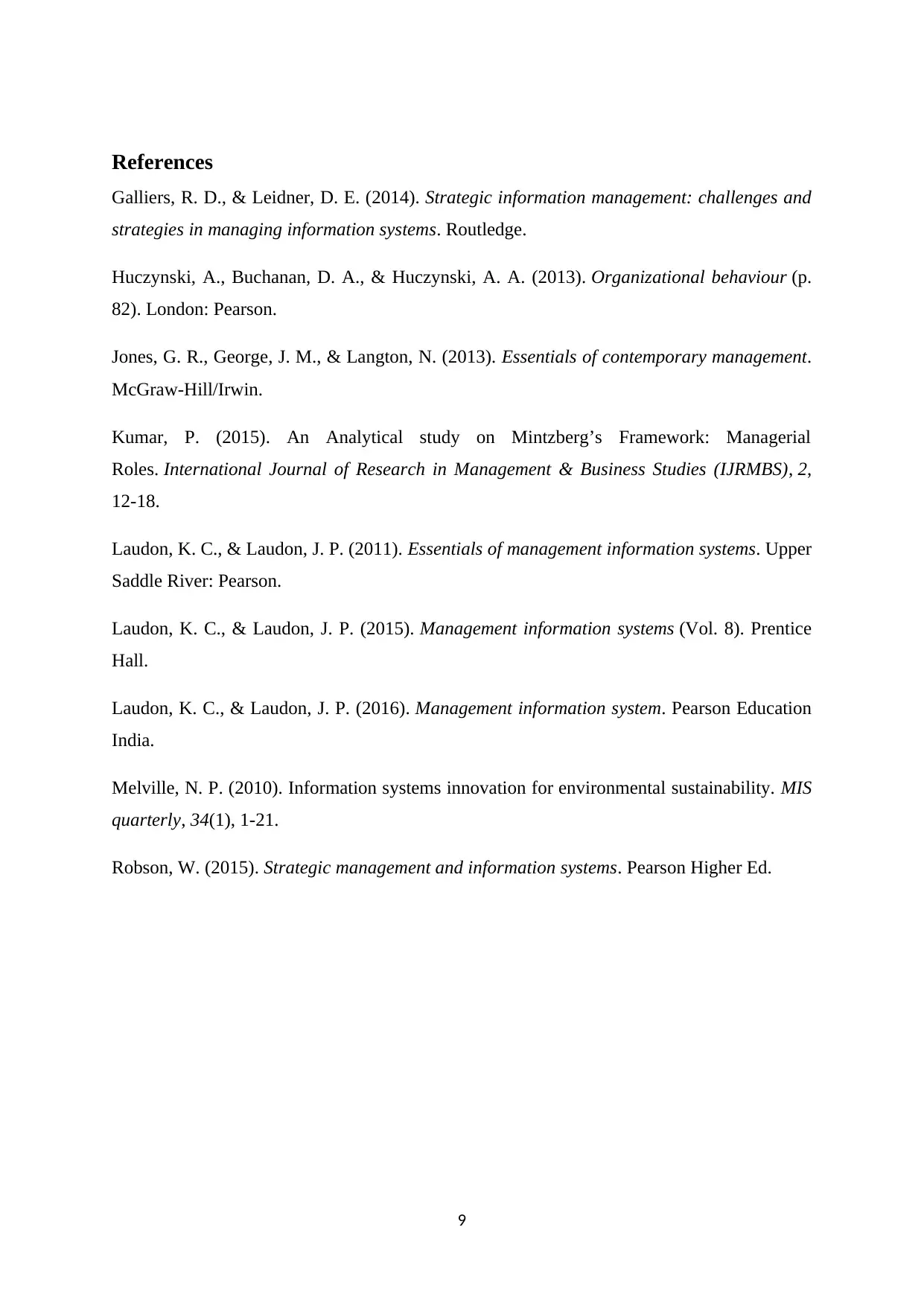
References
Galliers, R. D., & Leidner, D. E. (2014). Strategic information management: challenges and
strategies in managing information systems. Routledge.
Huczynski, A., Buchanan, D. A., & Huczynski, A. A. (2013). Organizational behaviour (p.
82). London: Pearson.
Jones, G. R., George, J. M., & Langton, N. (2013). Essentials of contemporary management.
McGraw-Hill/Irwin.
Kumar, P. (2015). An Analytical study on Mintzberg’s Framework: Managerial
Roles. International Journal of Research in Management & Business Studies (IJRMBS), 2,
12-18.
Laudon, K. C., & Laudon, J. P. (2011). Essentials of management information systems. Upper
Saddle River: Pearson.
Laudon, K. C., & Laudon, J. P. (2015). Management information systems (Vol. 8). Prentice
Hall.
Laudon, K. C., & Laudon, J. P. (2016). Management information system. Pearson Education
India.
Melville, N. P. (2010). Information systems innovation for environmental sustainability. MIS
quarterly, 34(1), 1-21.
Robson, W. (2015). Strategic management and information systems. Pearson Higher Ed.
9
Galliers, R. D., & Leidner, D. E. (2014). Strategic information management: challenges and
strategies in managing information systems. Routledge.
Huczynski, A., Buchanan, D. A., & Huczynski, A. A. (2013). Organizational behaviour (p.
82). London: Pearson.
Jones, G. R., George, J. M., & Langton, N. (2013). Essentials of contemporary management.
McGraw-Hill/Irwin.
Kumar, P. (2015). An Analytical study on Mintzberg’s Framework: Managerial
Roles. International Journal of Research in Management & Business Studies (IJRMBS), 2,
12-18.
Laudon, K. C., & Laudon, J. P. (2011). Essentials of management information systems. Upper
Saddle River: Pearson.
Laudon, K. C., & Laudon, J. P. (2015). Management information systems (Vol. 8). Prentice
Hall.
Laudon, K. C., & Laudon, J. P. (2016). Management information system. Pearson Education
India.
Melville, N. P. (2010). Information systems innovation for environmental sustainability. MIS
quarterly, 34(1), 1-21.
Robson, W. (2015). Strategic management and information systems. Pearson Higher Ed.
9
⊘ This is a preview!⊘
Do you want full access?
Subscribe today to unlock all pages.

Trusted by 1+ million students worldwide
1 out of 9
Related Documents
Your All-in-One AI-Powered Toolkit for Academic Success.
+13062052269
info@desklib.com
Available 24*7 on WhatsApp / Email
![[object Object]](/_next/static/media/star-bottom.7253800d.svg)
Unlock your academic potential
Copyright © 2020–2025 A2Z Services. All Rights Reserved. Developed and managed by ZUCOL.




